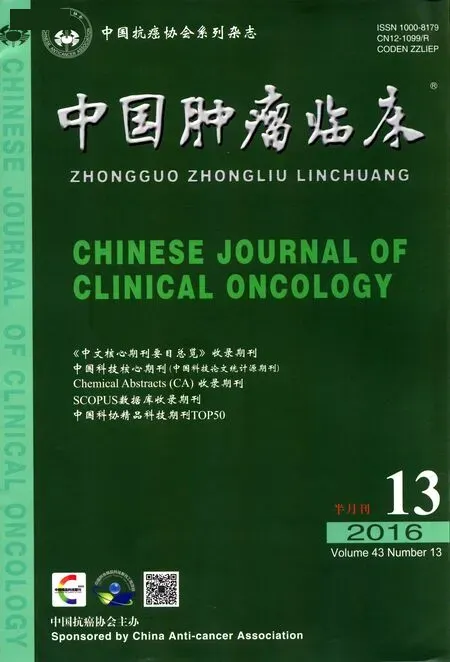小肠腺癌诊治进展
李开春 杜杰 程诗宇 综述 李进 审校
小肠腺癌诊治进展
李开春杜杰程诗宇综述李进审校
小肠腺癌(small bowel adenocarcinoma,SBA)是一种预后不良,发病率增加,且比较少见的肿瘤。该疾病常被延误诊断,大多数患者确诊时已为晚期。由于缺乏随机对照研究数据,临床治疗决策较为困难。根治性手术通常认为是必要的。辅助化疗预计是有益的,但仍未被随机研究结果证实。对于晚期SBA患者,回顾性研究表明以铂类为基础的化疗方案似乎最有效。靶向治疗仍缺乏足够数据支持。本文综述SBA的诊断与治疗进展。
小肠腺癌诊断治疗
小肠包括十二指肠、空肠和回肠。小肠肿瘤占消化系统肿瘤比例不足5%,主要包括腺癌、神经内分泌肿瘤、间质瘤以及淋巴瘤等[1]。小肠腺癌(small bowel adenocarcinoma,SBA)约占小肠肿瘤40%。SBA的发病率有地域差异,北美及西欧高发,亚洲低发。十二指肠是SBA的好发部位(55%~82%),其次空肠(11%~25%)和回肠(7%~17%)[2]。近年来,SBA发病率呈上升趋势,主要因为十二指肠腺癌的增长[3]。本文仅讨论SBA诊治进展。
1 诊断要点
1.1临床表现
SBA最初临床表现并不特异,诊断往往被延误。常见临床表现包括恶心、呕吐、体质量下降、贫血和腹痛等。Dabaja等[4]回顾分析217例SBA患者,66%患者诊断时表现为腹痛。SBA患者通常因为急腹症,如肠梗阻(40%)或肠出血(24%)就医而被诊断。
1.2检查手段
SBA确诊时多为晚期,优化改进检查手段尤为重要。CT扫描及MRI造影显像、双气囊小肠镜等可以更有效地诊断早中期患者。
Dabaja等[4]回顾性分析发现,通过上消化道内镜检查诊断SBA患者的比例为28%,手术为26%,钡剂造影为22%,CT扫描为18%,超声检查为3%,体检为3%。
1.2.1实验室检查SBA患者,外周血肿瘤标记物如CEA、CA199、CA50等可能正常或升高。伴有慢性出血者,可表现为便中隐血试验阳性和血红蛋白降低。
1.2.2特殊检查1)X线钡餐造影:X线钡餐造影检查敏感性较低,诊断小肠肿瘤的敏感性约为50%;2)CT及MRI检查:CT扫描已成为小肠肿瘤最主要的诊断方法。CT扫描诊断小肠肿瘤的准确率约为47%。随着灌肠螺旋CT及MRI的应用,小肠肿瘤的诊断率显著提高。有文献报道,多排螺旋CT小肠造影诊断小肠肿瘤的敏感性约为85%~95%,特异性约为90%~96%。磁共振注气小肠灌肠检查诊断小肠肿瘤的敏感性约为86%,特异性约为98%[2];3)上消化道内镜检查:可以发现十二指肠降部以上小肠肿瘤,且可活检明确诊断。限于技术,对于十二指肠降部以下的小肠肿瘤不易发现。近年来,双气囊小肠镜的临床应用在一定程度上弥补这一缺陷;4)胶囊内镜:胶囊内镜检查可以完整的探查整个小肠,且便于门诊进行。但有潜在肠梗阻的患者,不建议行胶囊内镜检查。对于不明原因消化道出血(常规胃肠镜检查未见明确出血灶),胶囊内镜检查具有优势,诊断小肠肿瘤的敏感性约为89%~95%,特异性约为75%~95%;5)双气囊小肠镜:双气囊小肠镜可用于范围广泛的小肠检查,但没有胶囊内镜方便。双气囊小肠镜的优势在于可以活检组织进行病理学确诊。有文献报道,双气囊小肠镜能够检测到胶囊内镜漏诊的小肠肿瘤[5];6)选择性肠系膜动脉造影:小肠肿瘤合并活动性出血时,选择性肠系膜动脉造影可发现造影剂自血管渗入肠腔。
2 治疗原则
手术切除是唯一可能的治愈方法。新辅助化疗可能使初始不可切除的患者获得根治手术的机会。SBA根治术后是否行辅助化疗仍有争议。一般建议Ⅱ期和Ⅲ期高危SBA患者术后行5-氟尿嘧啶(5-FU)联合奥沙利铂为基础的化疗方案6个月。就目前有限的循证医学证据表明,对于Ⅳ期患者且PS评分<2分,一线可选择FOLFOX(奥沙利铂+5-FU)或CapeOX(奥沙利铂+卡培他滨)方案化疗,二线可选择FOLFIRI(伊立替康+5-FU)方案化疗。抗血管内皮生长因子(vascular endothelial growth factor,VEGF)或表皮生长因子受体(epidermal growth factor receptor,EGFR)的单克隆抗体贝伐珠单抗或西妥昔单抗用于晚期SBA的疗效仍不确定。姑息性放疗可能是局部晚期十二指肠腺癌的一个治疗选择[7]。
3 治疗策略
3.1手术治疗
对于可行手术治疗的SBA患者,原发肿瘤和区域淋巴结完全切除(R0切除)是必须的。为达到更准确的疾病分期和较好的预后,通常推荐十二指肠腺癌手术清扫淋巴结5个以上,空回肠腺癌清扫淋巴结9个以上[8-9]。对于合并远处转移患者,不推荐切除原发肿瘤,除非出现肠梗阻、穿孔或者不可控制的出血。如果远处转移病灶和原发肿瘤可以分期或者同期切除,手术治疗的价值目前仍不确定。
3.2新辅助化疗
新辅助化疗指术前进行化疗。目的使肿块缩小,以及杀灭看不见的转移细胞,以利于后续的手术治疗。对于局部晚期SBA患者,新辅助化疗的地位缺乏足够证据支持。通常认为,对于原发肿瘤不可切除或者后腹膜淋巴结受侵,应考虑术前新辅助化疗,2~3个月新辅助化疗后再评估根治手术的可能性。新辅助化疗方案参照姑息化疗方案[10]。
3.3SBA的辅助化疗
辅助化疗指根治术后所进行的化疗。目的在于杀灭手术无法清除的微小病灶,减少复发,提高生存率。几项回顾性研究表明[11-13],SBA根治术后行辅助化疗并未生存获益。然而Overman等[14]回顾分析54例行根治性手术切除的SBA患者,术后行辅助化疗能够延长无病生存时间(disease-free survival,DFS)(HR=0.27,P=0.05),高危复发组(淋巴结≥10%阳性)辅助化疗能够延长生存(HR=0.04,P=0.04)。Ecker等[15]回顾分析1998年至2011年美国国家癌症数据库(National Cancer Data Base,NCDB)1 674例术后接受辅助化疗的SBA患者和3 072例单纯接受手术的SBA患者,辅助化疗能够延长Ⅲ期SBA患者的中位生存时间(overall survival,OS)(42.4个月vs.26.1个月,P<0.001)。
尽管缺乏足够证据支持术后辅助化疗,NCDB分析显示20年间(1985年至2005年)SBA术后辅助化疗比例上升16%(8%~24%)[16]。
鉴于5-FU联合奥沙利铂在晚期SBA姑息化疗和结直肠癌术后辅助化疗中的有效性,法国指南推荐5-FU联合奥沙利铂为基础的化疗方案(12个周期FOLFOX方案)用于ⅡB期和Ⅲ期SBA术后辅助化疗。对于低分化和清扫淋巴结<10个的ⅡA期SBA患者术后辅助化疗需要酌情考虑,其他ⅡA期和Ⅰ期SBA辅助化疗不推荐。
由国际罕见癌倡议发起的评估SBA的R0切除术后辅助化疗价值的Ⅲ期临床研究(BALAD研究)正在进行中。
3.4晚期SBA的姑息化疗
有回顾性研究表明[17-20],相比最佳支持治疗(OS 仅4~7个月),姑息化疗能够延长晚期SBA患者OS (11~15个月)。常用的化疗药物包括5-FU、卡培他滨、奥沙利铂、顺铂、吉西他滨和伊立替康等。5-FU药物与铂盐的结合临床验证是最有效的化疗方案。
有关晚期SBA化疗的最大样本研究(共入组93例患者)是来自法国的多中心回顾性AGEO研究[21],表明一线FOLFOX方案是最有效的含铂化疗方案。一线采用FOLFOX方案化疗的晚期SBA患者的中位无进展生存期(progression-free survial,PFS)为6.9个月,中位OS为17.8个月。日本一项回顾性研究发现,姑息化疗可以延长Ⅳ期SBA患者OS,中位OS为11个月,而未接受化疗的Ⅳ期SBA患者仅3.3个月[22]。
迄今为止,仍缺乏前瞻性Ⅲ期随机对照研究比较不同化疗方案治疗晚期SBA的疗效区别。两项前瞻性Ⅱ期临床研究[23-24],分别采用一线改良FOLFOX 和CapeOX方案治疗晚期SBA患者,客观有效率(ob⁃jective response rate,ORR)分别为48.5%和52.0%,PFS分别为7.8个月和11.3个月,OS分别为15.2个月和20.4个月。
基于以上数据,5-FU联合铂类可能被推荐为晚期SBA的一线化疗方案。具体化疗方案推荐FOLF⁃OX方案或CapeOX方案。发生于十二指肠乳头的进展期壶腹部腺癌,也可选择吉西他滨为基础的化疗方案[25]。
现有文献缺乏评估晚期SBA患者二线化疗的数据。法国AGEO研究[26]回顾性发现一线采用含铂化疗方案失败后,28例患者二线采用FOLFIRI方案化疗的疾病控制率为52%,中位PFS为3.2个月。
3.5晚期SBA的靶向治疗
尽管已有靶向药物应用于晚期SBA的个案报道[27-28],但目前仍缺乏抗血管生成药物和抗EGFR药物用于晚期SBA的确切疗效数据。评价抗血管生成药物和抗EGFR药物用于晚期SBA的疗效和安全性的Ⅰ期与Ⅱ期临床研究正在进行。
4 预后
SBA的部位、大小和TNM分期是独立预后因素,其中TNM分期是最重要的预后因素[29]。SBA总的5 年OS:Ⅰ期≥50%、Ⅱ期为40%~50%,Ⅲ期为10%~40%,Ⅳ期<5%[30]。
[1]Zaaimi Y,Aparicio T,Laurent-Puig P,et al.Advanced small bowel adenocarcinoma:Molecular characteristics and therapeutic perspectives[J].Clin Res Hepatol Gastroenterol,2015,22(7):559-599.
[2] Aparicio T,Zaanan A,Svrcek M,et al.Small bowel adenocarcino-ma:epidemiology,risk factors,diagnosis and treatment[J].Dig Liver Dis,2014,46(2):97-104.
[3]Reynolds I,Healy P,Mcnamara DA.Malignant tumours of the small intestine[J].Surgeon,2014,12(5):263-270.
[4]Dabaja BS,Suki D,Pro B,et al.Adenocarcinoma of the small bowel: presentation,prognostic factors,and outcome of 217 patients[J]. Cancer,2004,101(3):518-526.
[5]Ross A,Mehdizadeh S,Tokar J,et al.Double balloon enteroscopy detects small bowel mass lesions missed by capsule endoscopy[J]. Dig Dis Sci,2008,53(8):2140-2143.
[6]Novák J,Fabian P.Comments on the TNM classification of malignant tumours 7th edition[J].Klin Onkol,2011,24(2):149-150.
[7]Fadavi P,Zare M.Adenocarcinoma of small bowel[J].Rare Tumors. 2015,7(2):5517.
[8]Tran TB,Qadan M,Dua MM,et al.Prognostic relevance of lymph node ratio and total lymph node count for small bowel adenocarcinoma[J].Surgery,2015,158(2):486-493.
[9]Wilhelm A,Müller SA,Steffen T,et al.Patients with Adenocarcinoma of the Small Intestine with 9 or More Regional Lymph Nodes Retrieved Have a Higher Rate of Positive Lymph Nodes and Improved Survival[J].J Gastrointest Surg,2015.[Epub ahead of print].
[10]Schwameis K,Schoppmann SF,Stift J,et al.Small bowel adenocarcinoma-terra incognita:A demand for cross-national pooling of data [J].Oncol Lett,2014,7(5):1613-1617.
[11]Wu TJ,Yeh CN,Chao TC,et al.Prognostic factors of primary small bowel adenocarcinoma:univariate and multivariate analysis[J]. World J Surg,2006,30(3):391-398.
[12]Agrawal S,McCarron EC,Gibbs JF,et al.Surgical management and outcome in primary adenocarcinoma of the small bowel[J].Ann Surg Oncol,2007,14(8):2263-2269.
[13]Halfdanarson TR,McWilliams RR,Donohue JH,et al.A single-institution experience with 491 cases of small bowel adenocarcinoma[J]. Am J Surg,2010,199(6):797-803.
[14]Overman MJ,Kopetz S,Lin E,et al.Is there a role for adjuvant therapy in resected adenocarcinoma of the small intestine[J].Acta Oncol,2010,49(4):474-479.
[15]Ecker BL,McMillan MT,Datta J,et al.Efficacy of adjuvant chemotherapy for small bowel adenocarcinoma:A propensity scorematched analysis[J].Cancer,2015[Epub ahead of print].
[16]Bilimoria KY,Bentrem DJ,Wayne JD,et al.Small bowel cancer in the United States:changes in epidemiology,treatment,and survival over the last 20 years[J].Ann Surg,2009,249(1):63-71.
[17]Fishman PN,Pond GR,Moore MJ,et al.Natural history and chemotherapy effectiveness for advanced adenocarcinoma of the small bowel:a retrospective review of 113 cases[J].Am J Clin Oncol,2006,29(3):225-231.
[18]Czaykowski P,Hui D.Chemotherapy in small bowel adenocarcinoma:10-year experience of the British Columbia Cancer Agency[J]. Clin Oncol(R Coll Radiol),2007,19(2):143-149.
[19]Halfdanarson TR,McWilliams RR,Donohue JH,et al.A single-institution experience with 491 cases of small bowel adenocarcinoma[J]. Am J Surg,2010,199(6):797-803.
[20]Koo DH,Yun SC,Hong YS,et al.Systemic chemotherapy for treatment of advanced small bowel adenocarcinoma with prognostic factor analysis:retrospective study[J].Bmc Cancer,2011,11(2):205.
[21]Zaanan A,Costes L,Gauthier M,et al.Chemotherapy of advanced small-bowel adenocarcinoma:a multicenter AGEO study[J].Ann Oncol,2010,21(9):1786-1793.
[22]Nakanoko T,Koga T,Taketani K,et al.Characteristics and Treatment Strategies for Small Bowel Adenocarcinoma in Advanced-stage Cases[J].Anticancer Res,2015,35(7):4135-4138.
[23]Xiang XJ,Liu YW,Zhang L,et al.A phase II study of modified FOLFOX as first-line chemotherapy in advanced small bowel adenocarcinoma[J].Anticancer Drugs,2012,23(5):561-566.
[24]Overman MJ,Varadhachary GR,Kopetz S,et al.PhaseⅡstudy of capecitabine and oxaliplatin for advanced adenocarcinoma of the small bowel and ampulla of Vater[J].J Clin Oncol,2009,27(16):2598-2603.
[25]Ahn DH,Bekaii-Saab T.Ampullary cancer:an overview[J].Am Soc Clin Oncol Educ Book,2014:112-115.
[26]Zaanan A,Gauthier M,Malka D,et al.Second-line chemotherapy with fluorouracil,leucovorin,and irinotecan(FOLFIRI regimen)in patients with advanced small bowel adenocarcinoma after failure of first-line platinum-based chemotherapy:a multicenter AGEO study[J].Cancer,2011,117(7):1422-1428.
[27]Tsang H,Yau T,Khong PL,et al.Bevacizumab-based therapy for advanced small bowel adenocarcinoma[J].Gut,2008,57(11):1631-1632.
[28]De Dosso S,Molinari F,Martin V,et al.Molecular characterisation and cetuximab-based treatment in a patient with refractory small bowel adenocarcinoma[J].Gut,2010,59(11):1587-1588.
[29]Khan K,Peckitt C,Sclafani F,et al.Prognostic factors and treatment outcomes in patients with Small Bowel Adenocarcinoma(SBA):the Royal Marsden Hospital(RMH)experience[J].Bmc Cancer,2015,15(1): 1-11.
[30]Howe JR,Karnell LH,Menck HR,et al.The American College of Surgeons Commission on Cancer and the American Cancer Society.Adenocarcinoma of the small bowel:review of the National Cancer Data Base,1985-1995[J].Cancer,1999,86(12):2693-2706.
(2016-03-29收稿)
(2016-05-20修回)
Advances in diagnosis and treatment of small bowel adenocarcinoma
Kaichun LI,Jie DU,Shiyu CHENG,Jin LI
Correspondence to:Jin LI;E-mail:tianyoulijin@163.com
Department of Oncology,Tianyou Hospital of Tongji University,Shanghai 200331,China
Small bowel adenocarcinoma(SBA)is a relatively uncommon neoplasm with poor prognosis.However,the incidence rate of this condition increases.SBA is usually diagnosed at the late stages,and the majority of patients present with the advanced stage. Data are limited when making decisions for treatment because of the lack of randomized trials for SBA.Radical surgery is considered necessary when possible.Adjuvant chemotherapy is predicted to be beneficial,but this procedure has not yet been investigated through randomized trials.Platinum-based chemotherapy is apparently the most effective treatment regimen used in retrospective trials for advanced SBA.Targeted therapies,such as those against the angiogenetic pathway or the epidermal growth factor receptor pathway,have not yet been established for this type of cancer.This article reviews the progress in the diagnosis and treatment of SBA.
small intestine,adenocarcinoma,diagnosis,therapeutics
10.3969/j.issn.1000-8179.2016.13.363
同济大学附属天佑医院肿瘤科(上海市200331)
李进tianyoulijin@163.com
1.3TNM分期
SBA的TNM分类与SBA肿瘤分期[6](表1,2)。
表1SBA的TNM分类
Table 1TNM classification of small bowel adenocarcinoma
Note.The non-peritonealized perimuscular tissue for the jejunum and ileum is part of the mesentery.For the duodenum,it is part of the retroperitoneum in areas where there is no serosa
Item Primary tumour(T)TxT0 Tis T1 T1a T1b T2T3T4 Primary tumour cannot be assessed No evidence of primary tumour Carcinoma in situ Tumour invades the lamina propria,muscularis mucosa or submucosa Tumour invades the lamina propria or muscularis mucosa Tumour invades the submucosa Tumour invades the muscularis propria Tumour invades 2 cm or less into the subserosa or into the non-peritonealized perimuscular tissue(mesentery or retroperitoneuma)Tumour perforates the visceral peritoneum or directly invades other organs or structures,including: -other loops of the small intestine,mesentery or retroperitoneum by more than 2 cm -through the serosa into the abdominal wall -the pancreas(only for tumours in the duodenum)Regional lymph nodes(N)NxN0N1N2 Regional lymph nodes cannot be assessed No regional lymph node metastasis Metastasis in 1-3 regional lymph nodes Metastasis in 4 or more regional lymph nodes Distant metastasis(M)MxM0M1 Distant metastasis cannot be assessed No distant metastasis Distant metastasis
表2SBA的肿瘤分期
Table 2Tumor stages of small bowel adenocarcinoma
Stage T 0ⅠⅡA Tis T1,T2ⅡB ⅢA ⅢB ⅣT3T4 Any T Any T Any T N N0N0N0N0N1N2 Any N MM0 M0 M0 M0 M0 M0 M1

李开春专业方向为恶性肿瘤化疗和分子靶向治疗。E-mail:shtumor@163.com

